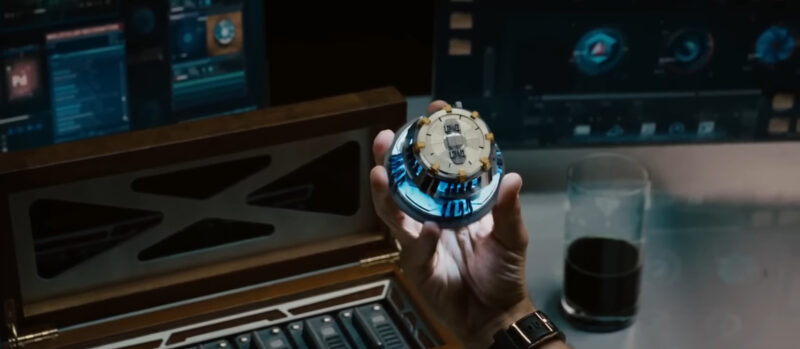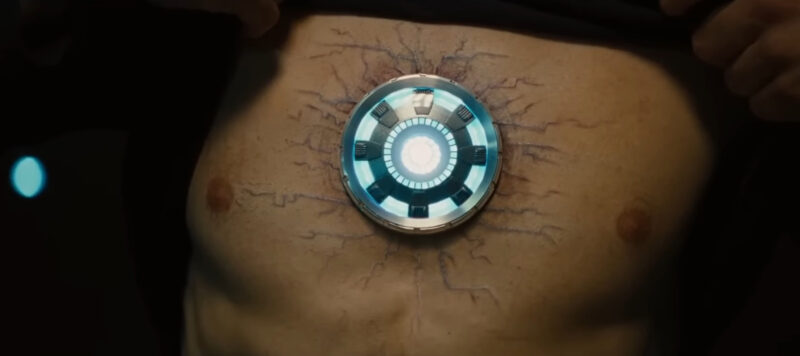Could Tony Stark’s arc reactor exist in real life? Probably not, but Gizmodo’s Ryan Carlyle made a valiant attempt to explain an almost realistic version of the science behind it.
As a disclaimer, he warns, “Now, I’m mixing real science and fake science here. So physics nerds and comic-book nerds: Deal with it.”
Is the Arc Reactor Really Possible
The arc reactor is some kind of fusion reactor that has the ability to generate an electromagnetic field, provide clean energy, and blow things up. In the comics, Tony Stark uses it for various purposes, primarily to recharge his armor and other electronic devices.
He also notably uses it in the film adaptation to power the magnet that prevents shrapnel in his chest from hitting his heart and killing him. Given that Marvel hasn’t provided an in-depth scientific blueprint of the reactor, Carlyle sifts through what’s known:
- The reactor has a palladium core.
- This palladium is affected by neutrons, hence the isotope matters.
- It’s fitted with electromagnetic coils structured in a torus.
- It emits a blue-white light.
- With moderate complexity tools, it can be built in a cave.
- It doesn’t necessitate any rare materials beyond what one might find in conventional weaponry.
- Its power runs low occasionally, pointing to some kind of fuel or charge consumption.
He then observes that the reactor, as it appears in the films, does not appear to have any of the distinguishing features of a thermal reactor, such as cooling loops or turbines. As a result, it must generate electricity directly without first generating heat, which makes sense, since a thermal reactor would likely burn Tony Stark’s chest.

The most important feature of the reactor is likely its palladium core. One of the palladium’s isotopes, Pd-107, produces silver when it undergoes a process called beta decay, in which it releases an electron when a neutron becomes a proton. In real life, there would be no net electrical current when the electron is released because the released electron balances out the proton count between palladium and silver.
So this is where “comic book physics” would have to come in because Tony Stark would need to come up with some kind of futuristic way to capture the electron that’s released, which would generate an electric current.
“I propose that Howard Stark found a way (using comic-book physics) to utilize the beta decay of Pd-107 ions as an electron source for the electron capture of Pd-103, thereby producing an electric circuit between two different radioactive isotopes.”
He theorizes that the electron capture process causes an influx of gamma waves towards the center of the reactor, while high-energy electrons are emitted from the center towards the rim. This imbalance of protons and electrons in the center would then cause a massive electrostatic potential that would afford the reactor its powers.
“Because this electron/photon counterflow creates a deficit of electrons (relative to protons) in the core, a massive electrostatic potential is developed and the palladium core attracts lower-energy electrons from the suit’s wiring. The ejection of electrons from the core towards the rim of the device produces an electrical cell capable of generating enormous voltage and current.”

His theory also goes a long way to explain the toxicity of the reactor, as Tony Stark was seen to suffer from palladium poisoning in Iron Man 2. First, he hypothesizes that the high-energy collisions within the reactor could easily have sent particles of the metal careening into his blood, but “this doesn’t explain the freaky circuit-looking lines on his chest, and it doesn’t explain why doctors can’t help him.”
However, another isotope of palladium decays into rhodium, and rhodium poisoning would better explain his symptoms: “Rhodium compounds also stain skin, and are highly toxic. (Chemical properties, Health, and Environmental effects) In fact, because most people have essentially zero exposure to rhodium, the toxicity of rhodium is very poorly understood.
This perfectly explains why Tony didn’t seek help from the medical establishment for his accumulated heavy metal toxicity – because he knew the doctors wouldn’t know how to deal with rhodium poisoning. Tony Stark didn’t have simple palladium poisoning, he had “palladium decay-product” poisoning!”
Final Words
In conclusion, while the arc reactor from Tony Stark’s world remains a marvel of comic book science, Carlyle’s attempt to bridge the gap between fiction and reality offers an intriguing perspective. By blending real-world physics with the imaginative realm of comics, he provides a theory that, while not entirely plausible, is certainly thought-provoking.
It serves as a testament to the endless possibilities that arise when we allow science and imagination to intersect. Whether or not the arc reactor could ever exist in our world, it’s fascinating to explore the “what ifs” and marvel at the boundless creativity of the human mind.
If you are craving more comic-based “what ifs,” do not miss our captivating article exploring the potential realm of jet-powered wingsuits.
Related Posts:
- Scientists Create a Real-Life Freeze Ray: Frozen in Awe
- How to Work With a Marketing Agency: Things you need To know
- Do Laser Scarecrows Work? Are They a Game-Changer…
- 16 Tips on How Do You Write a Work Instruction…
- Scientists Just Proved The Force Is Real Beyond 'Star Wars'
- Beyond the Myths: Investigating the Real Figures of…













